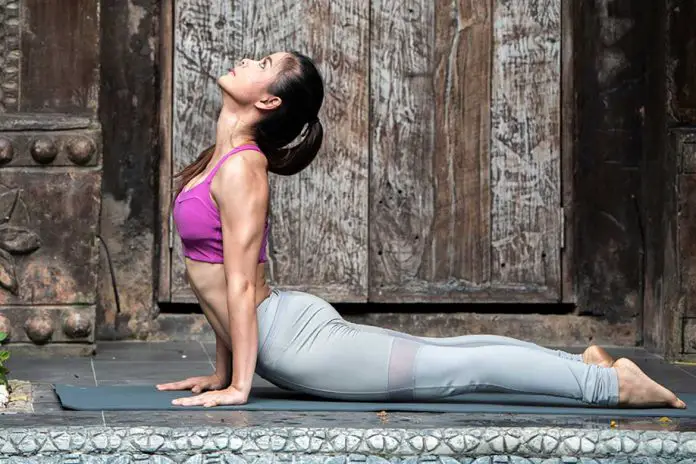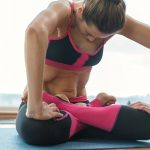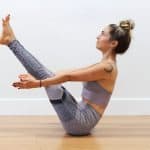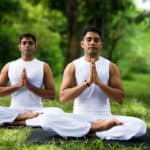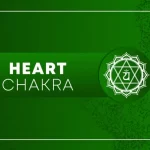The backbend pose known as Bhujangasana allows the practitioner to move their lower back and spine. Additionally, it encourages flexibility throughout the entire torso, which aids in enlarging the thoracic volume and ultimately enhances breathing capacity.
In addition, it aids in the strengthening of the muscles that surround the spinal column in the wrist, forearm, shoulder, and lower back. Bhujangasana is one of the simplest backbends that can be performed by practically all age groups because it falls under the beginner-level category of poses. Therefore, by consistently practicing Bhujanagasna in daily life, one can foster the equilibrium of their mind and body.
Bhujangasana Meaning
Sanskrit phrase translated as “Bhujang” means “snake” and “asana” means “Posture” is called “Bhujangasana.” When the practitioner thoroughly masters the stance, the asana represents a serpent with a hood. As a result, it ensures the practitioner’s fervent practice will be flexible like a snake.
The way a snake maneuvers around obstacles by bending and turning as a result of its body’s flexibility. Similar to this, practicing the Bhujangasana helps the practitioner build physical adaptation to the difficulties that come with increased back bending in yoga.
In addition, the snakes’ skin-shedding ritual, which renews the surface of their bodies, symbolizes rebirth, change, or new life. As a result, practicing Bhujangasana makes a person’s body even stronger and more flexible, which revitalizes life.
The 17th-century hatha yoga classic Gheranda Samhita describes the cobra stance (2.42-2.43). The pose is known as Sarpasana in the Sritattvanidhi of the 19th century, which also translates as Serpent Pose.
Practice Guide
Practitioners can go through the following points for the safe practice of Bhujangasana.
Contraindications of Bhujangasana
- Bhujangasana should not be performed deeper by practitioners who have sciatica or lower back pain. Before performing a fundamental backbend in Bhujangasana, one should speak with a qualified yoga instructor.
- This asana should not be performed by pregnant women or those who are menstruating. Practitioners should avoid this till or unless the body returns to normal in both crucial instances.
- Those who have had surgery on their waist, abdomen, or any other area that could be impacted by this pose should stay away from it. The newly produced tissues filling the incision may be put under stress as a result of this.
- One must stoutly forbid themselves from practicing if they have wrist, shoulder, neck, spine, or lower back ailments. It can exacerbate the current disease or harm that body part permanently.
How to Do Bhujangasana (Steps)
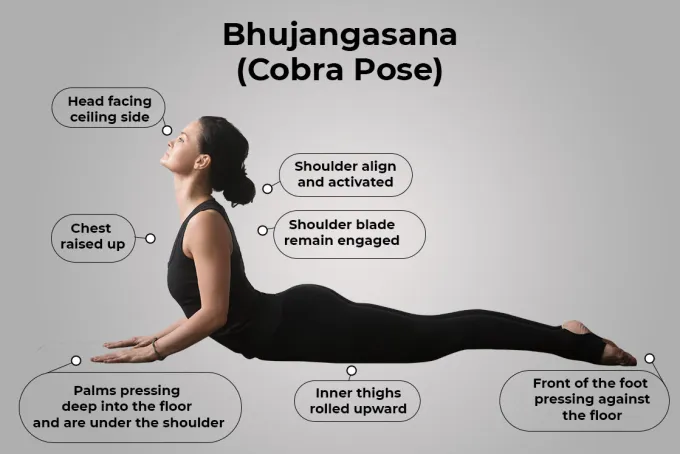
- Start by lying prone on the floor with your legs straight and your toes touching. Keep your hands by each side of your body.
- Now raise your hand from its current posture to shoulder height and lay your palms firmly on the ground with your elbows bent.
- After that, lift your upper body by lifting your neck, torso, and head by pressing your palm into the floor.
- Put pressure on your hips, thighs, and shoulder blades at this point. The neck and back arch will remain healthy as a result.
- Bhujangasana’s last pose should be held for 20 to 30 seconds, depending on your comfort level.
- From this position, slowly return by bending the neck, back, and chest until the head meets the floor. Place one arm beneath the other’s chin and place your head on it. Breathe now, and then unwind.
Precautions
Avoid injury and safe practice with precautions in Bhujangasana;
- Practitioners should pay close attention to where their hands are placed as they lift their upper bodies. The distance between the hands shouldn’t be excessively large or little. For the appropriate uplift, they should be directly under your shoulder.
- It’s best to avoid jerking movements when lifting the upper body because they could strain the muscles in the lower back. By releasing the lower ribs’ connection to the floor, one should always allow their body to softly enter Bhujangasana.
- Make sure that your legs or lower body remain straight as a practitioner starts to lift their body off the floor. Avoid this by pressing your pubic bone and the front of your feet together. This could lead to your knees swinging to either side of your body.
Beginners Tips
- Beginners with stiff lower backs and necks should refrain from using force in the cobra stretch in these two locations. When it comes to the neck, one should look down at the ground or refrain from looking up at the sky or ceiling. In contrast, bend your back as far as it can go.
- Due to inexperience, beginning practitioners may put more emphasis on their palms in order to lift their torso and deepen their backbend. However, doing so would be harmful. Rather than forcing, one should work on the expansion of the spine, which is essential for a proper backbend in Bhujangasana.
- Beginners would find it challenging to maintain the posture since their stiff bodies wouldn’t enable them to wait there for very long. In order to stretch your tailbone, roll your inner thigh up instead of compressing your buttocks.
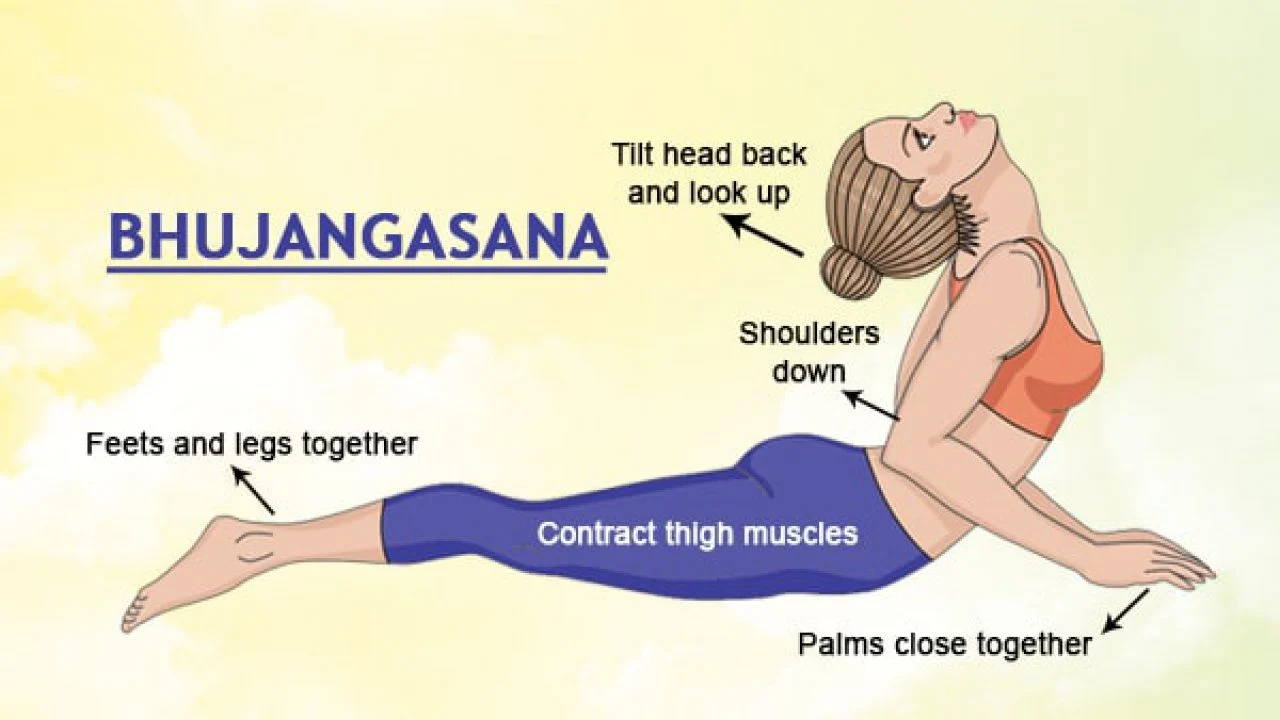
Modifications
Bhujangasana can be modified with the aid of simple props to prevent back injury:
- If one of the frequent issues experienced by practitioners when executing Bhujangasana is elbow swinging. So that they can stop them from wobbling, they can place a strap across the elbows.
- It could be difficult for a practitioner to bend their back in a straight hand if their lower body is rigid. So, by supporting the torso on the palms and forearms, one can lessen the bend in the lower back. In the end, the stress will be reduced.
- People who can easily do a back bend and are eager to challenge themselves in their practice. They can raise their foundation by placing blocks beneath their palms, which lets the spine to curve more sharply and improves flexibility.
Variations
To go deeper into the base cobra pose, its following variations can be practiced;
1. Crocodile Pose on Elbows
In Bhujangasana, hands remain under the shoulder while the head up gazing to the ceiling side and back arched. Whereas, with the crocodile pose, the palms hold the head support while the back has a slight bend.
Lay prone on the mat with your hands by your hips and your legs straight to start. Bring your hand over to the side and, as you inhale, lift your torso to gently stretch your lower back. Put your weight on your elbows and hands under your head after that. Hold this position for a while, then slowly return to being prone by removing your hand. After relaxing.
2. Cobra Pose Variation Elbow
In order to perform this variation of the cobra position, the torso must be slightly raised, the palms should be placed next to the floating ribs, and the head should be facing forward. The palms stay beneath the shoulder in Bhujangasana, however. Head tilted upwards as the spine is arched.
Start by resting prone with your hands next to your hips and your legs still straight. As you take a breath, lift your hands and place them next to the floating ribs. Finally, lift your chest, shoulder, and head by pressing the front foot into the floor and into the pelvis. In order to get back into the prone position, drop your chest, shoulders, and head while holding this position for a while. Then relax.
Therapeutic Use
The following conditions may benefit from therapeutic stretching in the cobra position:
- Sometimes due to pregnancy, hormonal imbalances, infections, diseases, trauma, and certain medications, there might be a delay in the menstrual cycle. Bhujangasana practice by toning up ovaries and uterus improves menstrual irregularities [efn_note] Effect of Yogasanas and Pranayama on Pain, Severity, and Quality of Life in Primary Dysmennorhea https://www.ijmedph.org/sites/default/files/IntJMedPubHealth-10-1-38.pdf [/efn_note].
- The regular practice of Bhujangasana has an impact on our body’s metabolism, which aids in reducing extra calories and body fat. In the end, this makes one thin and light.
Bhujangasana Benefits
The following health advantages are available to practitioners of Bhujangasana.
1. Improve flexibility
Stretching of the chest, shoulder, back, calves, and thigh muscles occurs as a result of practicing Bhujangasana. Energizing the muscle fiber Bundles helps to increase the range of motion in the muscles. increases the practitioner’s flexibility as a result.
2. Massages Abdominal organs
The abdominal area feels pressure due to the torso’s elevation. This has the effect of massaging the abdominal cavity’s organs, which enhances blood flow. This guarantees both their improved functioning and detoxification.
3. Strengthens reproductive system
In Bhujangasana practice, bending stimulates the pelvic area. This improves blood flow to the reproductive system, feeding the cells of the reproductive organs and strengthening them during exercise. However, this pose may also be beneficial for a number of male and female reproductive diseases.
4. Helps with diabetes
Holding for a longer period of time in this asana makes the muscles draw glucose for energy, which reduces instant glucose from the blood. However, According to one of the studies [efn_note] The beneficial effect of Yoga in diabetes https://www.researchgate.net/profile/Varun_Malhotra9/publication/7259161_The_benficial [/efn_note], it has been found that regular practice of this asana under right breathing interacts with the somatic endocrine mechanism, which further affects the insulin kinetics. Hence, helps with diabetes.
5. Stimulates chakra
The Anahata (Heart) chakra may be stimulated in Bhujangasana with the use of proper technique and efficient breathing. This further supports the healthy operation of the circulatory and respiratory systems.
6. Overcome pain due to sciatic nerve
Sciatic neuralgia is a form of radicular pain and is described as a disease of the peripheral nervous system, which causes a pricking pain in the following region of the body symptoms of Gridhrasi, like, pain over Sphik (waist), Kati (Back), Prushtha (Thigh), Uru (Hip), Janu (Knee), Jangha (calf region) extending up to Pada (Foot). As per the study [efn_note] a comparative study of Bhujangasana with Katibasti over only Katibasti in Grudhrasi (sciatica) https://core.ac.uk/download/pdf/333809886.pdf [/efn_note], the practice of Bhujangasana along with katabasis helps in the reduction of the sciatic nerve pain in the practitioners.
Conclusion
Bhujangasana is a simple to-do backbend pose that increases flexibility and muscle power. In addition, it massages the internal organs of the abdomen and aids in treating conditions like diabetes and sciatic pain.
Consequently, practitioners can engage in this posture to reap a number of health benefits.
















